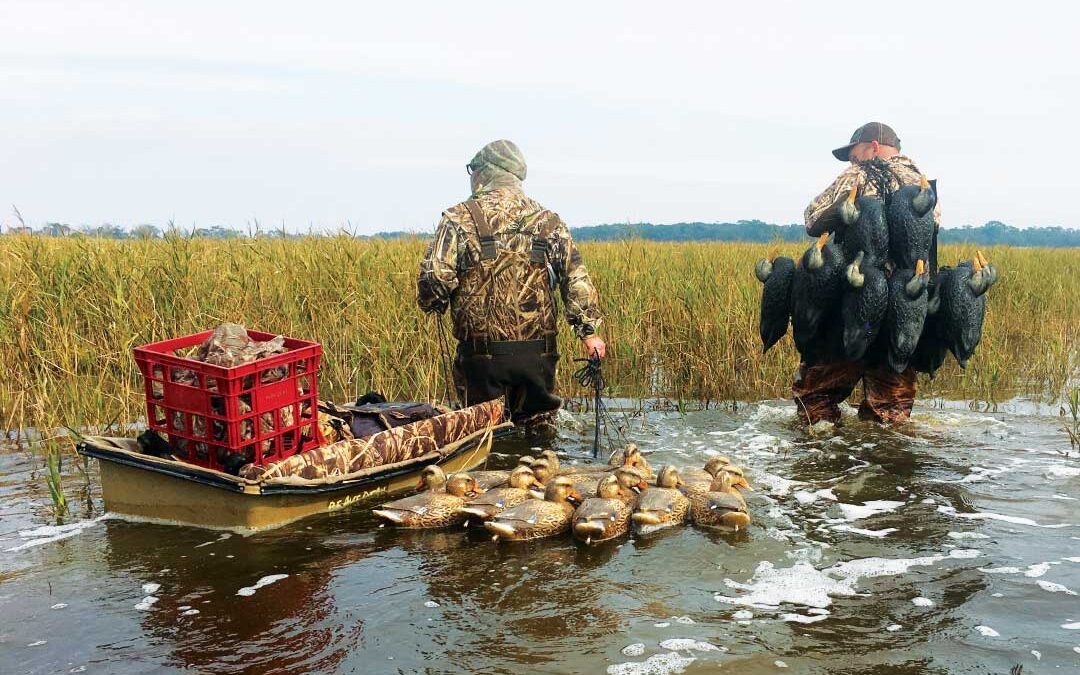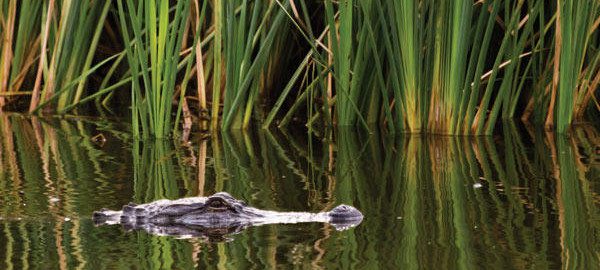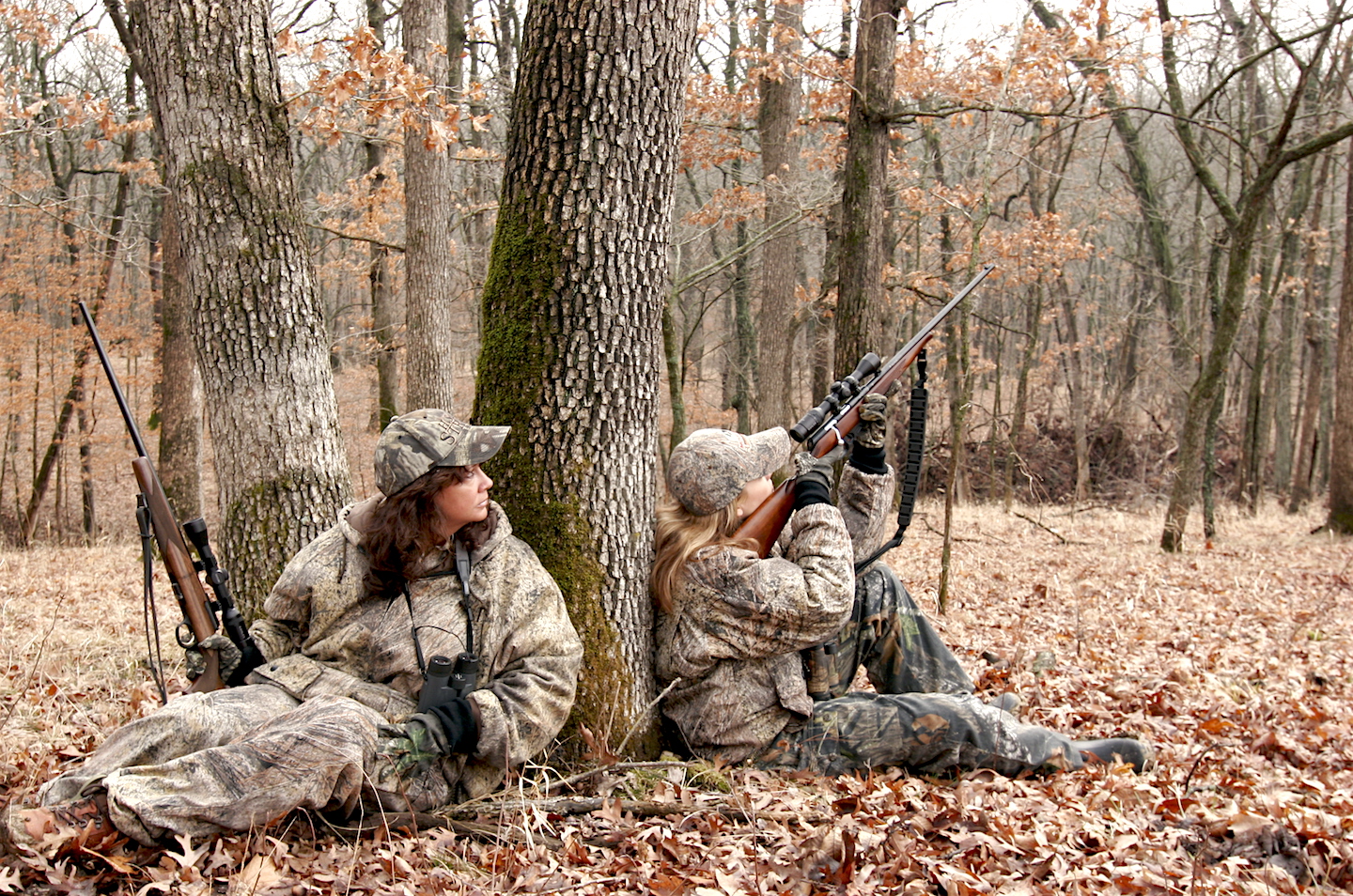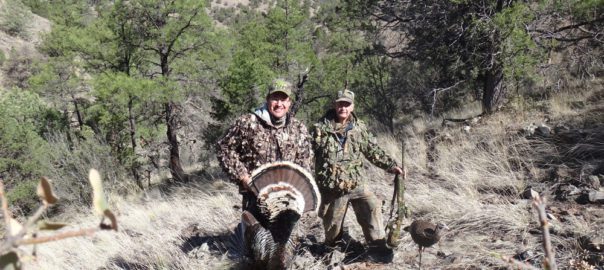Put a group of hunters from just about anywhere together in a duck blind and for that brief span of time all differences cease; they are, above all else, simply duck hunters.
Twenty minutes had passed since the boys had declared official shooting time. A black duck trio was spotted beating down the far side of our hole in the middle of a sprawling cattail marsh. Instinctively grabbing the call lanyard, I hit them with a loud series of descending notes. Two were apparently deaf, but the rear bird looked like a hit tetherball when it broke ranks and banked steeply toward us.
Quack-quack-quack-quack-quack, it kept sounding off all the way into the decoys and my gun barrel. It folded like a greeting card at the shot. A shaking-wet black Lab quickly delivered the first of many Pacific black ducks the week would render.
“Yes, mate, those blackies can be quite vocal at times,” said my host, Glenn Falla. “Welcome to Australia, mate.”
That first black duck would be one of many pleasant surprises during my week of hunting.
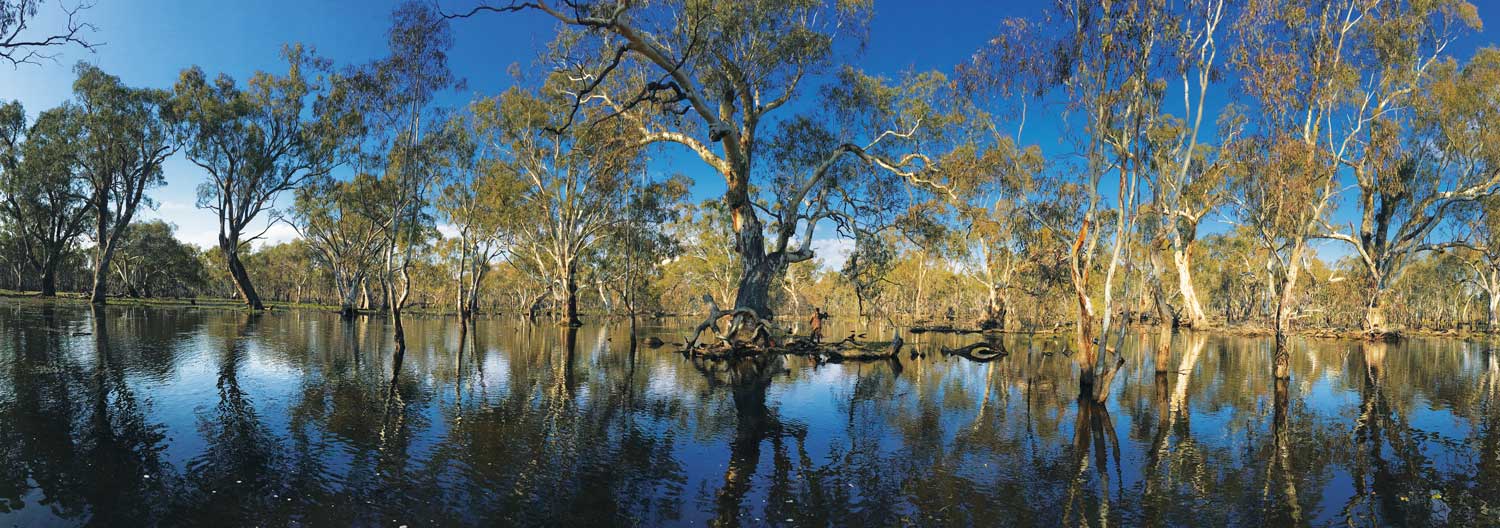
Getting Down Under had been a chore. My initial flight had been cancelled due to mechanical problems, so instead of arriving in Melbourne at 6:30 a.m., the flight landed shortly after midnight 18 hours late. Glenn, who lives an hour and a half from the airport, had just gone to bed when I called to tell him I’d arrived. After wheeling up to the curb on two wheels only an hour later, he asked if I wanted to rest or go hunting.
“We’ll sleep plenty in the grave, and after three full days of Airport Hell incarceration, I really need to air out,” was my quick response.
After a double-bacon cheeseburger topped with fried eggs and grilled pineapple from an all-night café, we were soon heading down a highway curling away from the city.
Victoria’s landscape was more like coastal Mississippi than the backdrop of Crocodile Dundee. The flat to gently rolling landscape was cloaked with warm-season grasses and perennial herbaceous cover that seemed similar to ours back home. Many even had the same common names. The thick humidity was likewise familiar.
Joining Glenn and myself were Trent Leen and Larney, his black Lab. I had hosted both men months earlier on a waterfowl hunt in Arkansas, during which they had promised to show me Australia’s version of the sport. In short order we arrived at a large cattail marsh where Glenn backed the boat down a worn, concrete ramp. I felt immediately at home when the mud motor roared to life.
We kicked up plenty of ducks during our loud ride in. Australia’s endemic duck species include Pacific black ducks (“blackies”), pink-eared ducks (“pinkies or wigeon”), hardheads, Australian shelducks (“mountain ducks” or “honkers”), maned ducks (“wood ducks”), grey teal, and chestnut teal. In some seasons, Australian shovelers, “bluewings,” are legal, depending on census results. The rare freckled duck has fidelity for certain wetlands and is strictly protected.
“They’ve buggered out for the time, but they’ll trickle back throughout the morning,” Trent explained while pitching two dozen over-sized black duck decoys from the boat. “They were fogging this spot yesterday morning.”
Sure enough, the ducks began working the area, mostly small flocks of black ducks. By mid-morning a breeze picked up, and so did the flights.
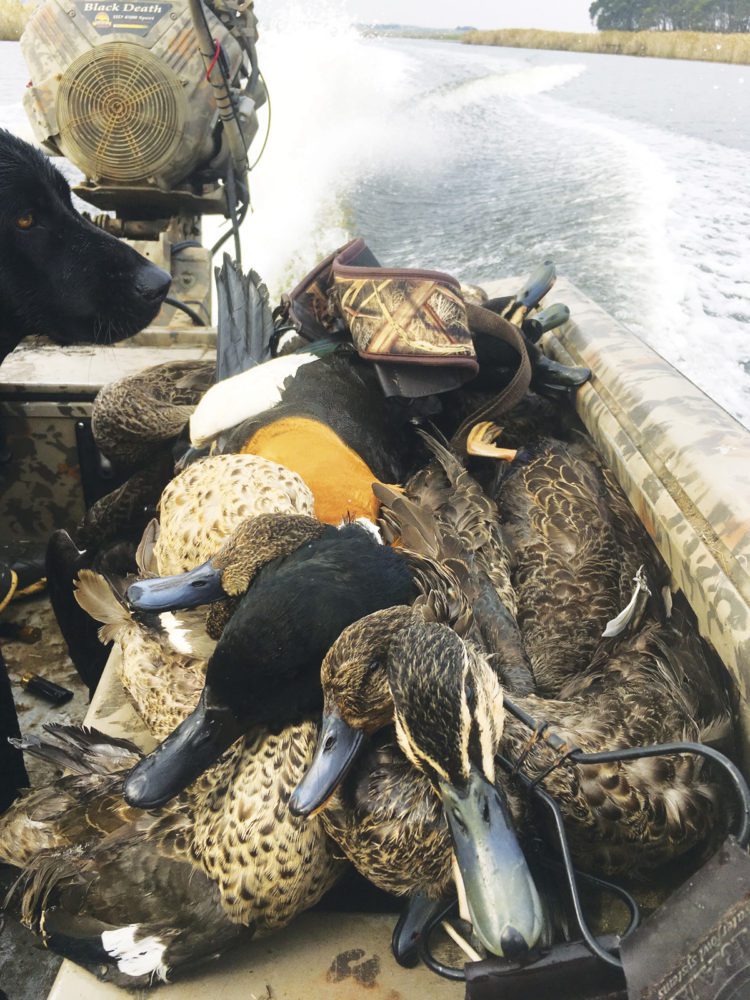
The fruits of a successful Aussie duck hunt.
Taking turns picking over singles and pairs, we worked together like parts of a well-oiled machine on the larger flocks. Having spent a few days together in an Arkansas blind, catching up between volleys came as naturally as chatting with your barber.
Glenn Falla is a compact bundle of energy with a ruddy complexion earned from time outside and a larger-than-life personality that’s never met a stranger. His quick wit is matched only by his catlike reflexes as he mounts a sleek over-and-under and deftly cuts through duck mobs with surgical precision. Affable and laid-back, Glenn was a 30-year ballistician for Winchester, where he developed the effective No. 5 steel load that travels 1,450 fps from their 2¾-inch hull.
“Sorry, mate,” he often reminded me with a devilish grin, “but they were designed specifically for the Australian duck hunting market.”
I felt almost doubly at home when hearing the daily limit was ten ducks. Thinking we’d missed our chance on a 12-pack of black ducks that had caught us deep into a forgettable discussion, we coaxed them nearer with a chorus of comebacks, soft quacks, and pleas. On the third swing they dumped abruptly into the pocket—the lead birds splashing paddles-down into the decoys, enticing the rearward bunch into crossing the magical 20-yard mark. We made them pay rent.
Still suffering whiplash from trying to swing through a pair of maroon-colored, low-flying hardheads that had streaked like lightning bolts through the decoys, I was beginning to believe that my sleep depravity had somehow enhanced my shooting prowess. That notion was shattered when a flock of chestnut teal butterflied over the decoys and I punched two holes worth of miss in their direction.
We pulled the decoys with about a half-dozen birds apiece swinging from the ends of our straps. After loading the boat and shucking waders, we visited with a few other local hunters, then hatched plans for the following morning. Later, we fueled our ambitions on hearty Anzac biscuits and deliciously sweet capsicum muffins prepared by Linda, Glenn’s wife.
That afternoon, we scouted a few properties and finished the day working over a few more black ducks in a flooded pasture. Back at Glenn’s home, the divine smell of crockpot-barbecued lamb’s shanks greeted us at the door. Tasting even better than they smelled, they proved to be a definitive southern hemisphere comfort food. Deep sleep came easily.
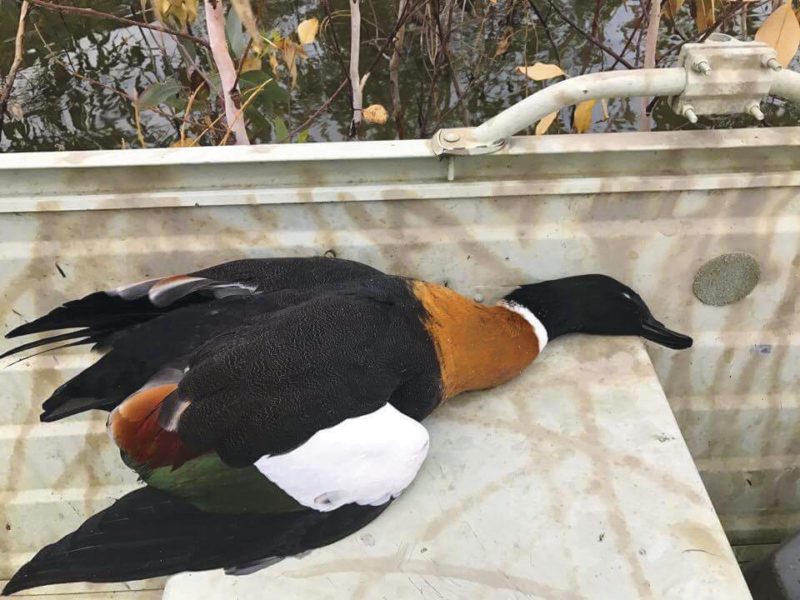
The Australian shelduck, or mountain duck, nests in tree holes or holes in stream banks. With its dark green head, white neck collar, and chestnut breast, the drake is one of the world’s most beautiful species of waterfowl.
The next morning found us motoring across the slick, blood-red surface of a reed-lined river, roiling the water into splintered shards of stained glass. Mobs of black ducks and grey teal sprang into air as we rounded each bend. Anticipation for what the morning would bring was as palpable as Larney’s wagging tail beating the boat-sides.
“I want you to experience everything Australia has to offer in the short time you’re here, mate,” Glenn yelled over the bellowing engine.
His plan was simple: We’d split into two groups and bounce birds between a couple of ponds. I walked across a flooded field and slid into a strip of sparse, head-high cover fringing a shallow pond. The grab-your-ankles mud and dense wall of vegetation felt perfectly at home.
I had barely caught my breath when a shelduck’s clown-nosed honk directly overhead had me scrambling. With time to only load the top barrel and swing quickly behind my left shoulder, I somehow managed to connect with my first “mountain duck” prize. Then things got serious.
Flocks of blackies and grey teal, seasoned with singles and pairs for good measure, intermittently swarmed the field. Coming off the river and flying headlong into the wind, they worked low over an irregularly strewn line of decoys. Singles and the occasional double continued to drift in, followed by a flock of shelducks that passed within range but remained unscathed.
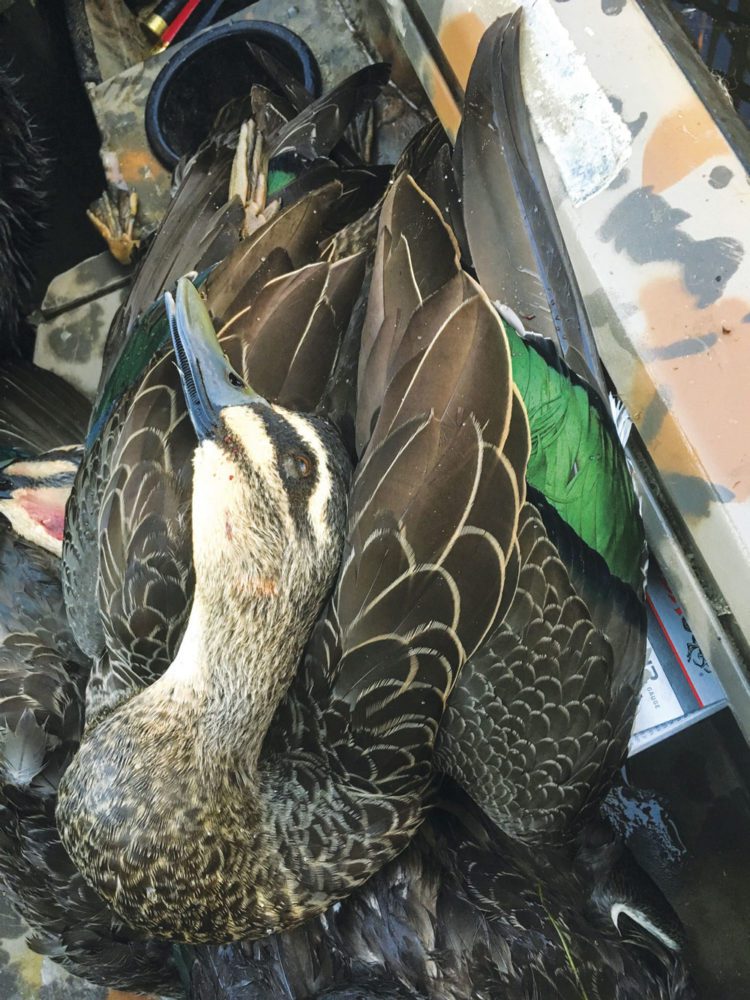
In addition to Australia, the Pacific black duck occurs in New Zealand, New Guinea, and Indonesia.
My ten-duck limit came quickly enough; the leather-strapped heft swaying across my shoulder felt especially gratifying as I sloshed back to the boat.
We moved north several hours’ drive to Glenn’s hometown in central Victoria, hoping that a particular “turkey dam,” as water storage dams are colloquially referred, would produce opportunities to add a couple of new species to the ubiquitous black ducks for which I’d developed a serious crush.
“Those pinkies are tiny little buggers,” Glenn reminded me as he dropped me off where the reservoir tapered to an end. Peering over the levee, I spotted piles of ducks, including pink-eared ducks and maned ducks. Hoping the machine-gun chatter of the camera drive wouldn’t spook them, I entertained myself while waiting for the signal.
At Glenn’s first shot the pond erupted in a towering plume of waterfowl. That was the signal. Sliding into a tall clump of cover, I waited for the inevitable rally. Picked from a pair of maned ducks, a fine, rusty-headed drake soon cartwheeled into the water with a splash.
A low-flying grey teal couldn’t be resisted. I’d passed on a tightly bound knot of tiny shorebirds before the light hit them just right and I realized they were pink-ears. Properly tuned, I dialed in on the next couple of flocks and picked up three beauties before the music stopped.
Pink-eared ducks are particularly unique with their zebra-striped chests, raccoon-like eye patches, pink ear patches, and a spatula-shaped bill, which has specialized, mandibular flaps for feeding on plankton—exactly what you’d expect in this land of platypuses, kangaroos, and koalas!
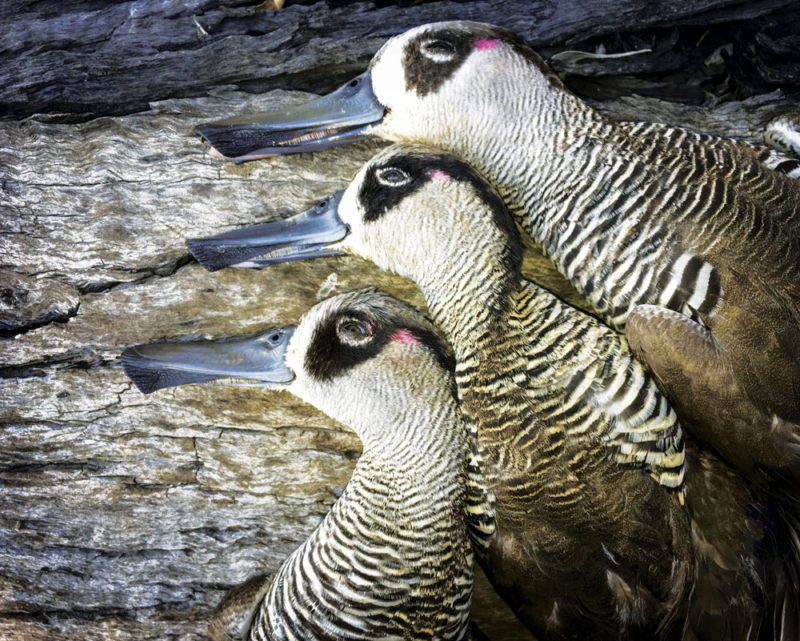
Pink-eared ducks are named for the tiny patch of pink just behind their eyes.
Swamps are among the most-hunted features throughout Victoria. These depressions, formed by volcanic activity over eons of time, hold water varying from one to ten feet in depth. We’d driven by plenty of wetlands that appeared to be nothing more than cemeteries for huge dead trees, but I’d not yet pieced it all together until the morning we tossed decoys onto a marsh several thousand acres in size.
We found ample cover a few hundred yards from shore in a swath of scattered young trees about twice as tall as ourselves. Out front was open water and a vast stand of dead, gnarly trees.
The ducks were conspicuously absent for the first half-hour. Then, like a magic spout had opened, they began to trickle in from all directions—left, right, behind, front—“no, mate, your other right.” Quacking black ducks, barking grey teal, meowing maned ducks; their calls echoed across the marsh while we communicated with soft whispers and whistles.
The spout opened wider . . . more ducks flew in. Glenn clobbered one bird from a pair of blackies, and I caught the other as it evacuated overhead. A single black duck from his side, a single one from mine; a pair tumbling in a flurry of flapping wings. Particularly challenging and memorable was a low-flying trio of grey teal that swept by at break-neck speed behind me and a high-flying “wood duck” that had tried sneaking past Glenn.
From the direction of the ancient woodland came a flock of 40-some gray teal that passed high and wide on the first turn. A staccato of barks turned them, and they passed low but out of range. Feeling red-faced and breathless, I stood on the call and once again turned them. We punched four birds from the flock as they made a third pass only 20 yards off the deck, and with that the spout clamped shut and the flight ended.
The penultimate afternoon’s scouting foray unfolded in an enchanting stand of flooded timber. Massive red gums towered overhead, their canopies seething with thousands of raucous, sulphur-crested cockatoos as bright as freshly laundered white linen. Small flocks of black ducks flushed ahead through intervals of sunbeams and shadows.
We’d waded a few hundred yards through shin-deep, coffee-colored water when we heard a sound like deer crashing through—except that it was kangaroos, dozens of them, which temporarily disrupted my spellbound reverie. We knew exactly where we wanted to hunt on my last day.
The next morning, after driving as slowly as an uphill racer on crutches to avoid colliding into the ’roos that bounced across the Land Cruiser’s low beams, we parked quietly and assembled our gear. With two black duck decoys, a mojo decoy, shotguns, and ammo-filled pockets, we skirted silently and lightless along the woodland edge. Quacks reverberating within the dark forest beckoned us through the murky, knee-deep water rife with submerged cap-floaters. Entering an elongated opening, ducks jumped from the tranquil surface as we approached.
We positioned the mojo 30 yards out front so it could be seen from all angles except the downwind approach, then placed the decoys in a small pocket and retired under a couple leviathan red gums. Our brief wait lasted only until the first sunbeam hit the decoys.
The morning’s first customers were two black ducks that skulked in silently on outstretched wings. Glenn’s bird bounced on a few limbs before splashing down, but my shots did little more than whittle some overhead branches. Redemption came with the next pair that responded to a few soft quacks and sailed into the decoys at can’t-miss distance, eyeball-high off the water.
The morning progressed at a perfect pace: neither so furiously that we couldn’t visit between volleys nor so slowly that we could drop our guard for a single moment. Other than a stray mountain duck and a few teal, the strap slowly but surely filled with fattened black ducks.
For two days we’d enjoyed a thousand-acre, public-use swamp entirely to ourselves, which is common midseason and during the week. When Glenn asked how many other hunters would have used the property back home, I truthfully answered, “We’d have had to spend the night here to share it with several groups that had traveled from as far as 500 miles away.”
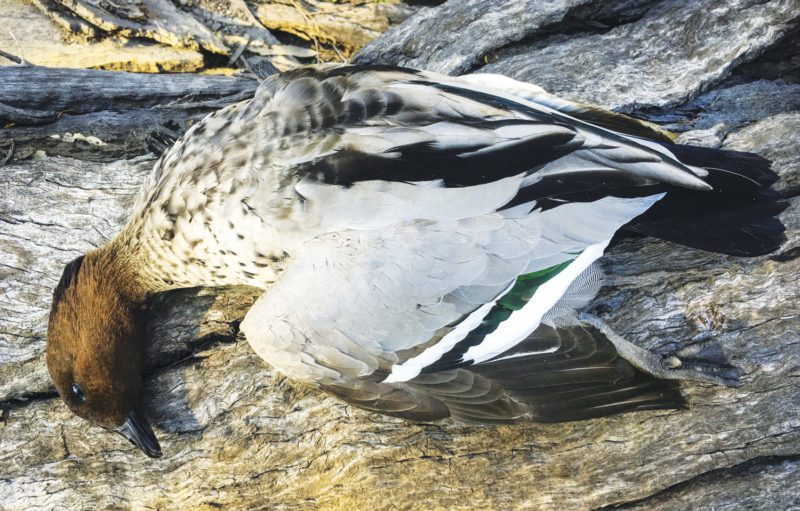
Maned ducks are found throughout Australia. The drake is gray with a dark brown head and mottled breast.
As if on cue, another pair of black ducks began to circle the hole.
With too much ground to cover in too little time, we came up short on cape teal and hardheads. The lost day due to cancelled flights didn’t help; neither did punching holes in the sky that first morning.
Despite all the prettier faces, the blackies stole my heart. Home or abroad, isn’t it usually just the hard-boiled basics of interacting with responsive ducks that makes one’s heart beat the strongest? Pacific black ducks made me feel perfectly at home.
The story of duck hunting repeats itself worldwide. Put a group of hunters from just about anywhere together in a duck blind and for that brief span of time all differences cease; they are, above all else, simply duck hunters. Scenery, species, local protocols, and tools of the trade may vary among locales, but the basic rules of the game remain unchanged. With friendly, English-speaking people and a long-standing tradition of duck hunting, Australia is surprisingly more similar to duck hunting in the U.S. than it is in most foreign destinations. And yet so wonderfully different.
IF YOU WANT TO GO
Ramsey Russell owns and operates GetDucks.com, a full-service agency specializing in worldwide hunting adventures for serious duck hunters. Wading the world’s unchartered wetlands, constantly searching for another great duck hunt, is his commitment to clients and personal life mission.
Australia is among the newest additions to a growing lineup that now encompasses six continents. In Victoria, the waterfowl season runs 90 days, from mid-March through mid-June, and in South Australia from mid-February through late June.
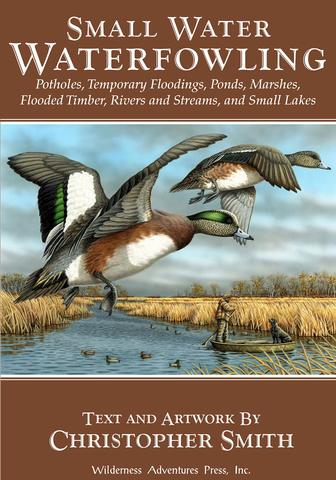 When it comes to actually shooting ducks and geese over water, the action is on the small places – the inland lakes, the ponds and potholes, the floodings and creeks and backwaters. Day in and day out, that’s where the ducks are, and that’s where Chris Smith takes you.
When it comes to actually shooting ducks and geese over water, the action is on the small places – the inland lakes, the ponds and potholes, the floodings and creeks and backwaters. Day in and day out, that’s where the ducks are, and that’s where Chris Smith takes you.
However, each of these places requires a separate technique, alternate decoys spreads and calling concepts, and different gear to use. He tells you how to approach each type of hunting for the weather and conditions. He knows when and when not to call. He describes the skills a good waterfowl dog needs to know for each place, things he’s taught his succession of Labrador retrievers over the years. Shop Now.

